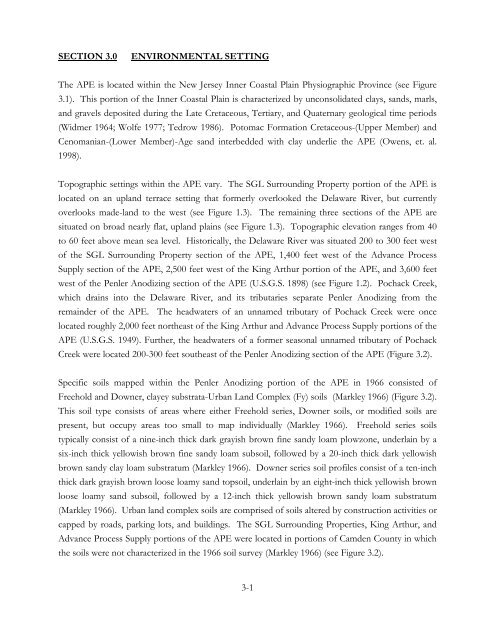APPENDIX D Cultural Resources Survey Report - US Environmental ...
APPENDIX D Cultural Resources Survey Report - US Environmental ...
APPENDIX D Cultural Resources Survey Report - US Environmental ...
You also want an ePaper? Increase the reach of your titles
YUMPU automatically turns print PDFs into web optimized ePapers that Google loves.
SECTION 3.0 ENVIRONMENTAL SETTING<br />
The APE is located within the New Jersey Inner Coastal Plain Physiographic Province (see Figure<br />
3.1). This portion of the Inner Coastal Plain is characterized by unconsolidated clays, sands, marls,<br />
and gravels deposited during the Late Cretaceous, Tertiary, and Quaternary geological time periods<br />
(Widmer 1964; Wolfe 1977; Tedrow 1986). Potomac Formation Cretaceous-(Upper Member) and<br />
Cenomanian-(Lower Member)-Age sand interbedded with clay underlie the APE (Owens, et. al.<br />
1998).<br />
Topographic settings within the APE vary. The SGL Surrounding Property portion of the APE is<br />
located on an upland terrace setting that formerly overlooked the Delaware River, but currently<br />
overlooks made-land to the west (see Figure 1.3). The remaining three sections of the APE are<br />
situated on broad nearly flat, upland plains (see Figure 1.3). Topographic elevation ranges from 40<br />
to 60 feet above mean sea level. Historically, the Delaware River was situated 200 to 300 feet west<br />
of the SGL Surrounding Property section of the APE, 1,400 feet west of the Advance Process<br />
Supply section of the APE, 2,500 feet west of the King Arthur portion of the APE, and 3,600 feet<br />
west of the Penler Anodizing section of the APE (U.S.G.S. 1898) (see Figure 1.2). Pochack Creek,<br />
which drains into the Delaware River, and its tributaries separate Penler Anodizing from the<br />
remainder of the APE. The headwaters of an unnamed tributary of Pochack Creek were once<br />
located roughly 2,000 feet northeast of the King Arthur and Advance Process Supply portions of the<br />
APE (U.S.G.S. 1949). Further, the headwaters of a former seasonal unnamed tributary of Pochack<br />
Creek were located 200-300 feet southeast of the Penler Anodizing section of the APE (Figure 3.2).<br />
Specific soils mapped within the Penler Anodizing portion of the APE in 1966 consisted of<br />
Freehold and Downer, clayey substrata-Urban Land Complex (Fy) soils (Markley 1966) (Figure 3.2).<br />
This soil type consists of areas where either Freehold series, Downer soils, or modified soils are<br />
present, but occupy areas too small to map individually (Markley 1966). Freehold series soils<br />
typically consist of a nine-inch thick dark grayish brown fine sandy loam plowzone, underlain by a<br />
six-inch thick yellowish brown fine sandy loam subsoil, followed by a 20-inch thick dark yellowish<br />
brown sandy clay loam substratum (Markley 1966). Downer series soil profiles consist of a ten-inch<br />
thick dark grayish brown loose loamy sand topsoil, underlain by an eight-inch thick yellowish brown<br />
loose loamy sand subsoil, followed by a 12-inch thick yellowish brown sandy loam substratum<br />
(Markley 1966). Urban land complex soils are comprised of soils altered by construction activities or<br />
capped by roads, parking lots, and buildings. The SGL Surrounding Properties, King Arthur, and<br />
Advance Process Supply portions of the APE were located in portions of Camden County in which<br />
the soils were not characterized in the 1966 soil survey (Markley 1966) (see Figure 3.2).<br />
3-1

















